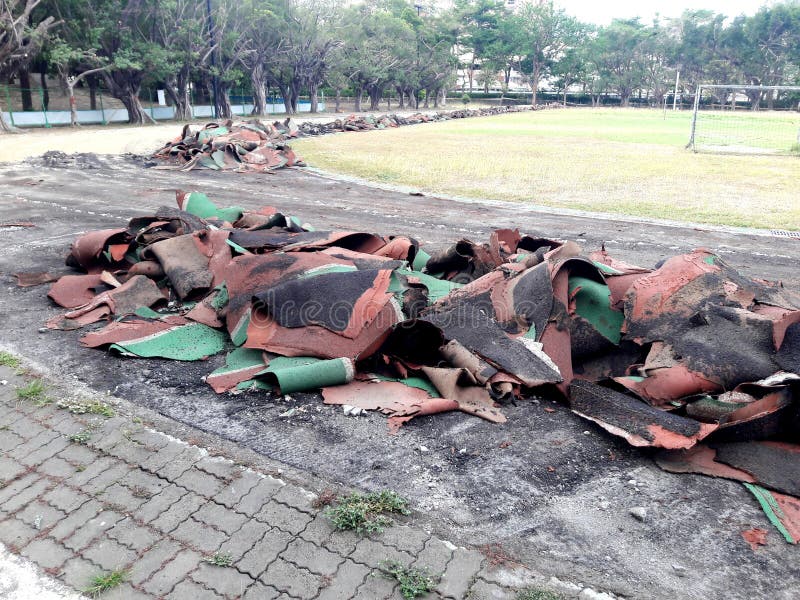Stadium Track Renewal In Time For Championships

Table of Contents
Assessing the Need for Stadium Track Renewal
Knowing when to initiate stadium track resurfacing is paramount. Ignoring the warning signs can lead to more extensive and costly repairs later. Several indicators signal the need for renewal:
- Cracked or worn surfaces: Significant cracks, holes, or areas of significant wear compromise the track's structural integrity and create tripping hazards.
- Fading or discoloration: Color fading indicates UV degradation and potential loss of performance characteristics.
- Uneven running surface: An uneven surface affects running times and increases the risk of injury. This is often caused by settling or improper installation.
- Loss of elasticity and cushioning: A hard, unforgiving track increases the impact on athletes' joints, leading to fatigue and injury.
- Excessive wear in high-traffic areas: Areas like the starting blocks and turns experience more wear, requiring closer monitoring.
Regular inspections, ideally conducted annually by qualified professionals, are crucial. These assessments should consider industry standards and regulations, ensuring your track meets the required specifications for competitive events, such as IAAF standards for international competitions. Professional assessments often involve specialized testing equipment to measure surface elasticity, hardness, and evenness.
Choosing the Right Stadium Track Resurfacing Material
Selecting the appropriate resurfacing material is a critical decision impacting both performance and longevity. Several options exist, each with its pros and cons:
- Polyurethane: Known for its durability, excellent performance characteristics, and ability to withstand heavy use, polyurethane is a popular choice, though it typically represents a higher initial investment.
- Rubber: A more cost-effective option than polyurethane, rubber still provides good performance and cushioning, making it suitable for many applications.
- Tartan: This high-performance material offers superior cushioning and elasticity, making it a preferred choice for elite-level competitions. However, it comes with a higher price tag.
The choice of material depends on several factors, including:
- Climate: Materials need to withstand the local weather conditions, including extreme temperatures and UV exposure.
- Budget: Balancing cost with performance is essential.
- Intended use: The frequency and intensity of use influence the required durability and performance characteristics.
It’s vital to choose materials that meet the standards set by governing bodies like the IAAF (International Association of Athletics Federations) to ensure eligibility for official competitions. IAAF certification verifies the track's compliance with specific performance and safety requirements.
The Stadium Track Renewal Process: A Step-by-Step Guide
Stadium track renewal is a multi-stage process requiring meticulous planning and execution:
- Surface Removal and Disposal: The existing track surface is carefully removed and disposed of responsibly, adhering to environmental regulations.
- Base Preparation and Leveling: The underlying base is thoroughly inspected, repaired, and leveled to ensure a stable and even foundation for the new surface. This is crucial for a long-lasting and even track.
- New Surface Installation: The new track surface is installed according to the manufacturer's specifications, paying close attention to detail to ensure a smooth and consistent finish.
- Curing and Testing: The new surface requires a curing period to achieve optimal strength and performance. Testing is conducted to verify compliance with standards.
- Final Inspection and Certification: A final inspection ensures the track meets the required specifications, and certification is obtained for official use.
Throughout the process, engaging experienced and qualified contractors is vital. Their expertise ensures the project is completed to the highest standards, minimizing the risk of delays or problems.
Managing the Timeline for Timely Stadium Track Renewal
Effective project management is critical to ensure your stadium track renewal is completed on time and doesn't interfere with scheduled championships or other events. Key aspects of planning include:
- Develop a detailed project schedule: This should account for each phase of the renewal process, including material delivery, installation, and curing time.
- Secure necessary permits and approvals: Obtain all required permits and approvals well in advance to avoid delays.
- Communicate timelines to stakeholders: Keep all relevant parties informed of the project schedule and any potential changes.
- Account for potential delays: Factor in potential delays due to weather conditions, material availability, or unforeseen circumstances.
Careful planning and proactive communication minimize disruption and ensure a smooth renewal process.
Invest in Your Stadium's Success with Timely Track Renewal
Timely stadium track renewal offers substantial benefits: improved athlete performance through enhanced surface quality, reduced risk of injuries due to a safer running surface, enhanced aesthetic appeal boosting the stadium's image, and compliance with regulations ensuring eligibility for competitive events. Planning is key, encompassing the selection of appropriate materials and the engagement of experienced contractors. Don't wait until your track is beyond repair. Schedule your stadium track renewal today to ensure your facility is championship-ready and provides athletes with the best possible competitive environment. Contact us for a free stadium track renewal consultation and let us help you invest in the success of your stadium.

Featured Posts
-
 Chantal Ladesou Reconnait L Autruche De Mask Singer 2025
May 12, 2025
Chantal Ladesou Reconnait L Autruche De Mask Singer 2025
May 12, 2025 -
 Chantal Ladesou Critique Ouvertement Ines Reg Elle Aime Le Conflit
May 12, 2025
Chantal Ladesou Critique Ouvertement Ines Reg Elle Aime Le Conflit
May 12, 2025 -
 Ufc 315 Belal Muhammad And Jack Della Maddalenas Tense Faceoff
May 12, 2025
Ufc 315 Belal Muhammad And Jack Della Maddalenas Tense Faceoff
May 12, 2025 -
 Experience The Houston Astros Foundation College Classic
May 12, 2025
Experience The Houston Astros Foundation College Classic
May 12, 2025 -
 Tva Klubbars Intresse Foer Thomas Mueller En Oeversikt
May 12, 2025
Tva Klubbars Intresse Foer Thomas Mueller En Oeversikt
May 12, 2025
